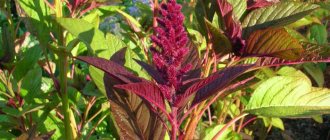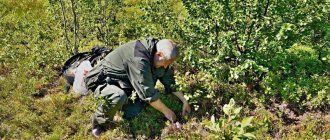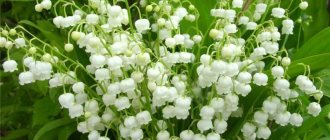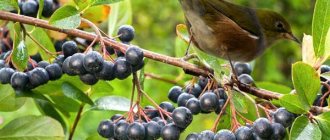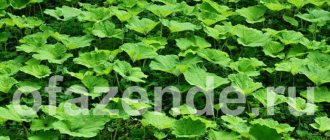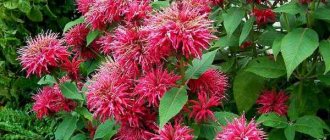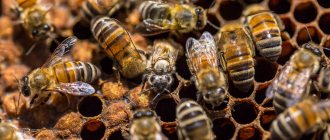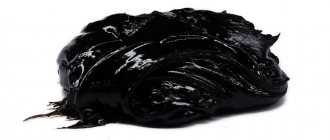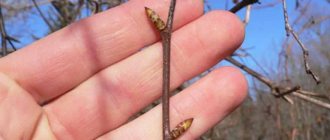Autumn colchicum (or autumn colchicum, lat. Colchicum autumnale) is a perennial herbaceous bulbous poisonous plant of the Colchicum family. Common names: timeless color, autumn winterweed, colchicum, osnyak, autumnweed, wild saffron, meadow saffron, autumn color, winterweed, spider flower, lousy flower, dog onion, dog's death, dogboy, devil's bread, poisonous crocus. Plants of this genus apparently received the name “colchicum” for their special rhythm of development - in the spring they have leaves that die off by the beginning of summer, and fruits, and they usually bloom in the fall, before the first snow.
Colchicum (colchicum) was described in the ancient Egyptian Ebers papyrus. It was known to the ancient Greeks and Romans. According to Dioscorides, most of the plants of this genus come from the Black Sea coast of Colchis, hence the Greek name Kolchikon, in the Latinized version Colchicum, which means “a native of Colchis”, the species name autumnalis in Latin. means "autumn" and indicates the time of flowering.
Colchicum was also involved in the success of the mission of the leader of the Argonauts, Jason. To obtain the golden fleece from the Colchisian king Eetus, Jason had to harness two fire-breathing bulls created by Hephaestus, plow a field dedicated to Ares and sow it with dragon teeth donated to Eetus by Athena. Medea, the daughter of Eetes, who fell in love with Jason, gave him a magic potion - the juice of the roots of the autumn crocus (meadow saffron), which grew from the blood of Prometheus chained to a rock. Jason, having washed his body, shield and sword with the juice of colchicum received from Medea, successfully completed the task.
The ancient Greeks believed that in Colchis there was a garden of the goddess Hecate, where poisonous plants grew - hemlock, henbane, hemlock and colchicum. The garden, according to legend, was surrounded by a high wall, the gate was guarded by huge dogs with burning eyes. Medea, according to legend, was a priestess (and according to some versions, daughter) of Hecate and had access to her garden. Medea owes her reputation as a sorceress, among other things, to the colchicum and the idea of it as a magical flower.
In fact, in ancient times, colchicums were used little in medicinal practice due to their strong toxicity; later they were not used for medical purposes for a long time and were forgotten. In the Middle Ages, under the influence of translations of scientific works of Arab doctors (including Ibn Sina), colchicum began to be used again in Europe as a medicine. Since the mid-16th century, plant preparations have been recommended for external use. Colchicum at this time was part of many medicines (for lumbago, asthma, rheumatism, dropsy), the exact composition of which was kept secret. One of these remedies was “Guson water” - a liquid that was used to treat rheumatism and gout; Its main component was an infusion of colchicum seeds in wine. Ancient herbariums, however, warned that colchicums are extremely poisonous and should not be used for internal use.
Over time, the plant began to be used less frequently due to the instability of the content of toxic substances in it (mainly in the corms) (which could depend on the place of growth, age of the plant, etc.), which made it impossible to accurately dose the drugs, and this is extremely dangerous , given the high toxicity. And also due to the presence of a large number of side effects. In 1820, French chemists P.J. Pelletier and J.B. Colchicine was found in cavanta in the composition of crocus, mistakenly believing that it was veratrine. In 1833 P.L. Geiger isolated this substance in crystalline form, calling it colchicine. In 1820, the English physician Williams proposed using its seeds instead of colchicum corms (due to the instability of the colchicine content in them) for medicinal purposes.
Description
Perennial corm medicinal plant, very poisonous, ephemeral. The corms are oblong (3-4 cm in diameter, up to 7 cm long), convex on one side, almost flat on the other, covered with dark brown membranous shells, elongated from above into a long neck.
The leaves are large (2-4 cm wide, 25-40 cm long), erect, 3-4 in number, green, glossy, broadly lanceolate, glabrous, fleshy, twisted into a low rosette on a false stem, appearing in spring. By the end of spring, the leaves wither and fall off. In summer, the crocus is in a state of vegetative dormancy. The stem is short (10-30 cm), bare, erect, surrounded by brown old leaves.
The plant blooms in the fall, from September to October (or even November), and has no leaves during flowering. Flowers - 1-3 in number - large, funnel-bell-shaped, regular, 6-petaled, bisexual, pinkish-lilac, similar to saffron flowers. There are 6 stamens, 3 columns, equal in length to the stamens, a pistil with a three-locular upper ovary.
The fruit of the autumn crocus is an ovoid-oblong (3-5 cm long), pointed, three-locular, leathery multi-seeded capsule - initially green, and brown when ripe, appears in the spring with leaves. Opens to the middle along the partitions. The seeds are round, 2.5 mm in diameter, dark brown, small. They ripen in a box the next year after flowering (June–July).
Colchicum grows in damp meadows, forest edges and clearings, among bushes, along rivers and streams in most areas of Europe (except Scandinavia); found in southern and western Russia, the Carpathians and Western Ukraine, Belarus, Lithuania, the Mediterranean, North Africa, the Caucasus and the Middle East, North America, Central Asia. Prefers sunny places or diffuse shade and loamy, nutritious, moderately alkaline, moist (but not waterlogged) soil. Frost-resistant, unpretentious.
Autumn colchicum propagates by freshly harvested seeds and daughter bulbs (1-3 per nest) in July-August (after the leaves dry and before the buds appear). It is better to plant it in spring. It is undesirable to keep in one place for more than 6 years due to severe depletion of the soil.
The healing properties of autumn crocus: “and there will be no more pain”
The bulbs and seeds contain a large number of toxic compounds. For this reason, they are used for medicinal purposes.
Autumn colchicum is considered especially valuable due to its 3 essential alkaloids:
- Colchicine. The bulbs contain up to 0.7% of the valuable substance, and the seeds contain over 1.2%. Its main functions include: restoration of protein metabolism, slowing down cell division and delaying the movement of leukocytes to foci of inflammation.
- Colchicine. Based on it, many drugs are created that are derivatives of colchicine.
- Colhamin. It has an analgesic effect and also helps lower blood pressure. Although this alkaloid causes diarrhea, it still inhibits lymph and leukocytosis processes. As a result, inflammation occurs much faster.
Among other things, this delicate flower is rich in:
- tannins;
- lipid compounds;
- fats;
- resins;
- aromatic esters;
- organic acids.
The medicinal properties of autumn crocus also include its ability to destroy pathogenic fungal microorganisms and prevent their development or appearance.
In this regard, the plant is used as a remedy that:
- relieve various types of inflammation (for gout);
- inhibit the division of malignant cells;
- change the structure of tissues responsible for hematopoiesis;
- reduce the pain threshold.
Also, infusions or tinctures of perennials are used as a diuretic. In just a few doses, it helps remove stones or sand from the kidneys.
In addition to oncology, drugs containing colchicum (Latin name) are used in the treatment of rheumatism, joint diseases, and also for wound healing. In addition, these medications perfectly relieve swelling.
Preparation of medicinal raw materials
Due to the EXTREME TOXICITY of autumn crocus, pharmaceutical preparations of the plant are currently used mainly for treatment.
Corms harvested in the fall, before flowering begins (September - early October), are used for medicinal purposes. They are freed from the roots and aerial parts, cleared of soil and used dried (cut into pieces and dried) or fresh. Colchicum corms should not be washed, as this reduces the quality of the raw material.
Autumn colchicum flowers and seeds are also used. The seeds are harvested at full maturity - the boxes with them are cut off in June-July, after acquiring a brown color. The boxes are dried, then the seeds are removed from them and further dried. Colchicum raw materials are dried in a warm place (at temperatures up to 40º) or in the sun, spread out in one layer. The shelf life of fresh bulbs is 3 months, and dry seeds and flowers are 12 months.
Since all parts of the plant are poisonous, raw materials should be stored in tightly closed, labeled glass jars separately from other supplies and out of the reach of children in a dark place. Raw materials are not sold in pharmacies.
When preparing and storing medicinal raw materials of autumn crocus, as well as when working with it in the garden, you should be careful, work only with gloves, and do not give it to children.
Why is the crocus dangerous?
If you are trying to understand why colchicum is dangerous for humans, then first of all, absolutely all areas of such a flower are poisonous. But the most dangerous are considered:
- Plant bulbs.
- Seeds.
The flower's bulbs and seeds contain high levels of alkaloids such as colchicine and colchamine. These substances belong to the group of mitotic poisons.
Colchicine. The substance provokes severe hypertension of the mucous membranes of the gastrointestinal tract. It also minimizes the release of trace elements such as insulin and histamine.
Colhamin. This substance is 15 times more toxic than colchicine. It should be borne in mind that even during heat treatment (cooking or frying), toxic substances are not destroyed.
Experts have found that even six grams of colchicum seeds contain a lethal dose of alkaloids for an adult. And for a child, the lethal dose is 2 grams of seeds.
When people are looking for an answer to the question of why colchicum is dangerous, they should know that most often poisoning from this flower occurs at those moments when its bulbs and seeds are eaten. Tinctures based on colchicum, which people sometimes use for self-medication, are also especially dangerous. Therefore, there is no need to take risks and try the first folk recipes that you saw on the Internet, since ignorance in the use of certain means can lead to serious consequences. But the way the crocus blooms will not leave any person indifferent, which is why this flower is very popular among gardeners.
Watch the video about the TOP 10 poisonous flowers.
Beneficial features
Alkaloids (colchicine (0.8% in flowers, 0.25% in corms, 1.2% in seeds) and colchamine, colchicerine, speciosamine) were found in all parts of autumn crocus.
The corms of the plant contain organic aromatic acids, phytosterols, flavone apigenin and carbohydrates; the seeds contain fat, carbohydrates, tannins and resins, macro- (K, Mg, Ca, Fe) and microelements (Cu, Mn, Zn, Cr, Co, Al, V, Se, Sr, Ni, Pb, B).
Plant composition
First of all, you need to know that autumn crocus contains alkaloids such as colchamine and colchicine in quantities sufficient to cause very severe poisoning if used incorrectly. The composition of the plant is also characterized by the content of the following substances:
- fats;
- carbohydrates;
- resins;
- organic acids;
- Sahara;
- flavonoids;
- starch;
- tannins;
- phytosterols;
- sterols.
The mineral composition of colchicum is highly concentrated:
- zinc;
- gland;
- copper;
- Selena;
- potassium;
- calcium.
Beneficial features
Colchicum has found application in the production of medicinal products and folk medicine due to the following properties:
- pain reliever;
- anti-inflammatory;
- anticancer;
- antiemetic;
- antimicrobial;
- diuretic.
Application
In medicine
Preparations of autumn colchicum are used by official medicine as a cure for leukemia, asthma, post-infectious nephritis and cancerous tumors. They are also used to treat lumbago, rheumatism, and gout. They have some diuretic effect.
Colchamine, contained in autumn colchicum, is a potent anti-blastic agent, exhibits anti-cancer properties and is used for exophytic and endophytic forms of skin cancer of stages I-II (0.5% kolhamin (omaine) ointment), as well as for leukemia, blood diseases, cancer of the stomach (in combination with sarcolysin) or esophagus, in cases not subject to surgical treatment.
For chronic myeloma leukemia, colchamine is prescribed intravenously or orally: it causes a decrease in the number of leukocytes in the blood, lymph nodes, spleen and gives more or less long-term remissions. Treatment with colhamine for relapses is less effective.
Colchicine, obtained from the plant, is used to treat gout. In Greece, Germany, France and Indonesia, autumn crocus (autumnal colchicum) is cultivated as a medicinal raw material.
Other uses
It is cultivated as an ornamental plant, notable for its late flowering, when there are almost no flowering plants left in parks and gardens. The plant is very beautiful. However, if there are children in the family, it is better to refrain from planting it, as there is a high risk of poisoning.
There have been cases of people being poisoned by the milk of cows and goats that have eaten this plant. Colchicine, isolated from autumn crocus, is used in plant breeding.
Contraindications for use
Preparations based on colchicum are contraindicated in the following cases:
- allergy to components;
- diseases of the gastrointestinal tract and cardiovascular system;
- pregnancy and lactation;
- renal failure;
- purulent infections;
- alcoholism;
- inhibition of myeloid hematopoiesis.
Particular caution is required when prescribing colchicum to weakened and elderly people, as well as to patients who have undergone surgery or a severe infection.
Treatment with autumn crocus
Autumn colchicum is used in official medicine and homeopathy; its seed extract is the main component of the anti-gout tablets Colchicum-dispert .
For exophytic and endophytic forms of skin cancer of stages I-II, colhamine (omaine) ointment (0.5%) is used, causing the breakdown of tumor tissue. The affected area of skin is lubricated with ointment, applying 1-1.5 grams of it. using a spatula. The ointment, especially in combination with hyaluronidase, easily penetrates the skin of the body and mucous membranes and has a selective effect against cancer cells, practically without disturbing the structure of normal tissues. By the end of treatment, tissue epithelization occurs with a good cosmetic effect. It is more effective to treat skin cancer in the early stages, without any preliminary effects. In case of an overdose of the drug, local or general symptoms of intoxication (poisoning) may occur.
To speed up treatment, it is recommended to add hyaluronidase (lidase), ephedrine (or metazone) and butadione to colhamine ointment.
An ointment based on an alcohol tincture of autumn crocus seeds or bulbs. 10 gr. 100 ml of colchicum bulbs or seeds is poured. vodka, kept for 20 days, filtered. Used externally as a rubbing treatment for polyarthritis deformans, gout and rheumatism, neuralgia . 2-3 drops of tincture are mixed with 1 table. l. melted pork fat or butter, rub the sore spots once a day. You cannot increase the dose of tincture or the number of rubbings to prevent overdose and poisoning. Before use, be sure to consult a doctor.
Application of autumn colchicum: from theory to practice
Since the plant is rich in toxic substances, it is important to consult your doctor before consuming it. The doctor will calculate the dosage of medications and the frequency of medications. He will take into account the individual characteristics of the patient, as well as the condition of his body as a whole.
According to statistics, self-medication with folk remedies prepared from seeds and bulbs of the crop ends in death.
Herbalists offer several recipes for preparing colchicum tincture. It is used for severe rheumatic pain by rubbing the inflamed areas.
The recipe for the medicinal drug is simple:
- take 1 part of chopped dried perennial bulbs;
- pour 5 parts of ethyl alcohol (50%);
- insist for 2 weeks.
The resulting infusion is used for compresses. Only a doctor can say exactly how long you will need to keep the lotion for the desired result. At the same time, vinegar infusion is perfect for rubbing, as it has an analgesic effect. Dried raw materials are poured with apple cider vinegar in a ratio of 1:12. After 2 weeks of infusion, it can be used by rubbing 1 tsp. in one go.
In other cases, herbalists advise preparing a medicine for internal use. It helps with cystitis, urolithiasis, rheumatism and swelling.
For this you will need:
- crush the torn onions (2 pcs.);
- pour them with alcohol (200 ml);
- Send the container to a dark corner for 14 days.
Take this medicine 3 times a day. The maximum single dose is 2 drops. However, even this can cause poisoning. If the patient feels sick, vomits or feels acute pain in the stomach, then you should immediately go to the hospital.
A tincture of the seeds is made as a pain reliever. 10 g of raw material is poured with ½ glass of ethyl alcohol. After 21 days, the mixture is filtered. Take the essence three times a day, 1 drop, or rub it into the skin.
Infusion of autumn colchicum
How difficult it is to endure acute or aching pain in the bones. Therefore, gout, arthritis, radiculitis or rheumatism are treated with infusions from this perennial. In these cases, the mixture is used externally.
To prepare a remedy, you need:
- take ½ teaspoon of dried raw materials;
- pour 0.5 liters of boiling water;
- leave for 2 hours;
- strain, carefully squeezing out the contents.
Rubbing is carried out up to 6 times a day. The minimum dosage for one dose is 1 ml. If irritation and allergies are not observed, it is gradually increased to 8 ml.
Healing ointment from colchicum
The preparation of the ointment is carried out in a completely different way. To begin, grind 300 g of dried or fresh onions in a blender. The juicy mass is poured with cold liquid (0.5 l). The container is sent to a water bath. After 30 minutes, remove and filter. To obtain the desired consistency, the broth is mixed with a fatty base using butter or Vaseline. Store the composition in a hermetically sealed container at +5˚С. This content of the product will help preserve all the medicinal properties of autumn colchicum.
The use of the proposed folk remedies will only be beneficial if the patient constantly consults a doctor.
Loading…
Contraindications
ALL PARTS OF THE PLANT ARE EXTREMELY TOXIC, the bulbs and seeds are especially toxic. For this reason, any colchicum preparations can be used only on the recommendation and under the supervision of a doctor. Ingestion of plant juice can have serious consequences for human health, including death. Even the water in which colchicum flowers stood is poisonous.
Flower growers must always wear gloves when working, since the juice from damaged plant bulbs is extremely toxic. 6 gr. Autumn colchicum seeds contain a dose of alkaloids that is lethal for an adult. For a child, the lethal dose is 1.5-2 g. seeds
Colchicum-disperse ointment (made from colchicum alkaloids) is contraindicated for stage III–IV skin cancer.
Colchicum preparations are contraindicated for pregnant and lactating women, children under 12 years of age, and people with severe inhibition of the hematopoietic function of the bone marrow.
Colchicum poisoning. Symptoms
The main symptoms of colchicum poisoning are: nausea, vomiting, acute abdominal pain, bloody or watery diarrhea, burning sensation in the throat, tenesmus, weak arrhythmic pulse, low blood pressure, oliguria. There may be a weakening of muscle tone or convulsions, weakening of breathing (up to paralysis), initially a strong increase and then a decrease in body temperature, delirium, loss of consciousness, and disturbances in blood composition. Poisoning develops quite slowly, after 2-6 hours.
First aid for colchicum poisoning
As first aid for autumn crocus poisoning, activated carbon (2-3 tablespoons with 0.5 liters of water) is prescribed, followed by gastric lavage with a 0.1% solution of potassium permanganate. It is necessary to call an ambulance - it is important to take the victim to the hospital as quickly as possible.
Drinking plenty of water, milk, and tea is recommended. Subsequently - the introduction of an isotonic solution of sodium chloride (up to 1 liter subcutaneously, drip), glucose (5% solution subcutaneously or 10 ml of a 20-40% solution intravenously). If breathing is impaired with cyanosis, oxygen is prescribed.
You will find many more interesting and useful things on the “Book of Health”!
Clinical picture of colchicum poisoning
Autumn colchicum (Colchicum autumnale) Plena
In general terms, Colchicum poisoning proceeds as follows. Nausea, vomiting, abdominal pain, watery or bloody diarrhea, tenesmus, burning sensation in the throat, low blood pressure, weak arrhythmic pulse, oliguria. There are convulsions or weakening of muscle tone, a decrease in body temperature, weakening of breathing up to its paralysis, and delirium. Poisoning develops slowly, after 2-6 hours.
A more detailed examination of the poisoning process in the clinical picture distinguishes three phases of toxic action:
- Phase 1 is the period of early manifestations of poisoning (2-12 hours), in which symptoms arise mainly from the gastrointestinal tract (nausea, vomiting, diarrhea, abdominal pain), tachycardia, chest pain. In case of severe poisoning, symptoms from the gastrointestinal tract can be pronounced, hemorrhagic gastritis, vomiting with blood and water-electrolyte imbalance associated with vomiting develop; blood pressure decreases, reflex bradycardia occurs.
- Phase 2 - the period of formation of multiple organ failure (24-72 hours) - is the most dangerous. Most deaths occur during this period. Hemorrhagic syndrome associated with thrombocytopenia and liver damage dominates. In addition, the development of intoxication is accompanied by increased fibrinolytic activity. In the second phase, hyperthermia, peripheral neuropathy, dysfunction of the cardiovascular, respiratory systems and parenchymal organs develop. Life-threatening arrhythmias and asystole are most likely between 7 and 36 hours. Suppression of bone marrow functions occurs, threatening septic complications; often central manifestations of toxic effects in the form of delirium, and depression of consciousness up to coma. Inhibiting mitosis in Schwann cells. Colchicine causes the development of muscle weakness, areflexia, and peripheral sensory neuropathy.
- Phase 3 - the period of consequences of intoxication (7-10 days). A new clinical sign here is the development of alopecia (hair loss). The body functions damaged by the poison are gradually restored.
Regardless of the route of entry into the body of colchicine, the symptoms of poisoning with it develop slowly, and the clinical picture is extended over time; there is a phased course of its course. Most often, septic complications develop in the period from 3 to 7 days. During the 3rd phase, the functions of systems and organs are restored, however, in case of severe poisoning with this poison, the temperature reaction and blood dyscrasias persist for a long time (A.P. Efremov, 2001).
Planting Colchicum
When to plant
Colchicums love sunny areas, although they grow well in light partial shade. If you plant crocus in the deep shade of trees, it will become easy prey for slugs. Colchicums like soil that is well-drained so that the roots do not get wet from stagnant water. Colchicum grows in both acidic and alkaline soil, and feels good even in clay, if it is not too heavy and not oversaturated with moisture. Peonies and junipers are preferable as neighbors for the colchicum, which will be able to distract the eye from its yellowed foliage with their bright greenery.
The planting time for autumn-blooming colchicum is mid-August, when the plant is in its dormant period. A large colchicum bulb can produce a flower in the first year.
How to plant
Colchicum is planted in open ground at a distance of 10-20 cm between specimens, and the depth of planting of the bulbs depends on their size - from 8 cm for small bulbs to 20 cm for large ones. When planting, superphosphate is added to the soil at the rate of one tablespoon per 1 m² and a liter jar of wood ash for the same area. When plunging the bulb into the soil, make sure that the long tube formed by the scales peeks out of the ground: the bud will pass through it, like a tunnel.
Do not cut this pipe under any circumstances, otherwise the flower will have to push a heavy layer of earth while germinating.
Before planting, a bucket of humus and half a bucket of sand per 1 m² are added to the soil for digging. Colchicums from bulbs bloom in about 6 weeks.
Poisonous plant autumn colchicum. Life cycle features
Colchicum reproduces by bulbs formed during natural division. In spring, bouquets of green leaves up to 30 cm long appear from huge bulbs, covering a very low three-lobed fruit box, and it seems that buds are about to appear. But the leaves dry up, and nothing reminds us that a real miracle is being prepared underground at this time. And in early autumn, quite unexpectedly, tender, tight buds appear in a bare place. Beautiful funnel-shaped flowers up to 20 cm high, light purple, pinkish or white flowers bloom on a thin stem without leaves. That is why this time-confusing plant is called autumn crocus, and also autumn wintergreen, timeless color, autumn color.
It looks like science fiction, but the ovary of this plant is located not in the flower, but in the bulb.
After fertilization, she spends the winter there. In spring, along with the leaves, it is born, forming a fruit-box. The seeds in it ripen quickly and fall out at the same time as the leaves wither. Not knowing all these subtleties, people thought that the ovary appeared before the color, and they called this amazing plant “the son before the father.” This life cycle is characteristic of plants called summer ephemeroids. The meaning of such oddities is to wait out the summer drought, since the territory where the genus Colchicum itself was formed is the sultry Mediterranean.
Anderson's Tradescantia, or, as it is also called, Garden Tradescantia, is one of those unassuming plants that, with a minimum of care and care, give us their beauty every day. It blooms in early summer and remains decorative throughout the season. Tradescantia foliage is also decorative - narrow long leaves form rounded mounds.
Is Colchicum a poisonous plant?
The presence of exotic and original plants in your own garden always speaks of the gardener’s special extravagant taste. Colchicum can easily be considered one of these unique plants. Unfortunately, not everyone has information about how Colchicum is poisonous. But this is not a reason to refuse such an interesting plant.
Colchicum - autumn snowdrop or miracle of the autumn garden
Autumn colchicum will decorate your garden when almost everything has already bloomed. This amazing flower is also called the autumn snowdrop.
We will tell you what it looks like and how it grows later in this article.
Autumn colchicum - what kind of flower is this?
Plants sense the approaching cold and the approaching change of seasons.
How can you find out? They dry out, there are fewer flowers, the smell weakens, and the petals fall off.
The most important thing for plants now is to form and disperse seeds, which will allow them to be reborn next year.
Perennials accumulate reserves of nutrients underground, in the roots. When there are enough of them, they will fall asleep peacefully.
But this does not mean that your garden will look gray and dull.
Autumn colchicum (lat. Cólchicum autumnále) is probably the most famous bulbous plant that blooms at the turn of summer and autumn.
Description of the plant
Nature has established an unusual life rhythm for the autumn crocus, a little hasty.
In the spring it produces leaves, and then for a short time, about two months, it collects organic compounds in underground tubers and finally dries up.
But this is just a short sleep, which is interrupted by the August heat.
And instead of waiting for spring, the colchicum is now in a hurry to show off its buds and flowers, thanks to which the garden takes on a festive, truly spring look.
What does the autumn colchicum flower look like - photo
autumn colchicum
Autumn crocus flowers are purple, pink or white, reminiscent of the March bloom of crocuses.
Important!
Autumn colchicum is a poisonous plant; its leaves, tubers and even seeds contain colchicine. But this is good news for gardeners, because such a dangerous flower rarely becomes the target of pest attack.
Although colchicine, found in colchicum, is poisonous, it is used in some painkillers and in the treatment of cancer.
How to care for a plant?
Colchicum grows quickly on fertile soils.
From each old tuber, two or even three young ones are formed per season.
Beautiful and large in the spring, the leaves of the autumn crocus die off in mid-summer, and a period of dormancy begins for the plant.
But there's no need to worry about that.
Colchicum leaves that have lost their decorative effect can be disguised with the help of other perennials or herbs.
No need to worry about tubers either.
You can plant them once and enjoy autumn crocus flowers for years.
It is at the beginning of autumn that it is better to buy tubers for planting.
The secret to the lush growth of most bulbous flowers is not only fertile soil, but also proper drainage.
These plants do not like swampy places and will rot if the soil contains excess moisture.
What flowers can you plant with autumn colchicum?
As a companion for colchicum for cool autumn days, we also recommend planting cyclamen neapolitan tubers.
It has wonderful patterned leaves and winters well. It usually blooms until the end of October.
If it grows in good soil rich in humus, it can repeat flowering every year without special care. Like the crocus, it grows quickly.
Sternbergia yellow also blooms in the fall.
The flowers of this plant resemble yellow crocuses, and sometimes Sternbergia blooms in early spring. They are also good company for autumn snowdrops.
Use of colchicum in folk medicine
As stated, colchicum is widely used in folk medicine, although many knowledgeable people categorically do not recommend using this potent poisonous raw material for self-medication, since the danger from such experiments may be much higher than the possible positive effect.
Colchicum infusion
An aqueous infusion of colchicum is prepared as follows: crushed dried root of the plant (no more than 1/2 teaspoon) is poured with boiling water (0.5 l), the resulting mixture is infused for two hours, filtered and squeezed. It is used internally for jaundice, whooping cough, dropsy, aching bones due to a cold, rheumatic, neuralgic pain, and heart weakness.
Colchicum tincture
It has been noted that the alkaloids contained in colchicum help with rheumatic pain. To do this, you can prepare an alcohol tincture of colchicum: the dried corms need to be crushed and poured with a 50% solution of ethyl alcohol in a ratio of 1:5, left in a dark place for 15 days and used as lotions and compresses.
To relieve pain in the joints and back, you can prepare a vinegar tincture from colchicum according to a similar recipe by mixing dry crushed roots with 9% vinegar at the rate of 1 part raw material to 12 parts vinegar. Insist for the same two weeks. Use as a rub in small doses.
For cystitis, edema, and urolithiasis, a tincture of fresh crocus bulbs is used: the raw material (2 medium-sized bulbs) must be grated, taking the necessary precautions, pour in 0.2 liters of vodka, the infusion period and conditions are the same. Take no more than two drops orally three times a day with plenty of water. The first dose should be taken in an even smaller volume and wait longer to ensure that there are no negative reactions or symptoms of poisoning.
Also in folk medicine, a tincture of colchicum seeds is used to relieve pain: 10 g of seeds should be poured with undiluted ethyl alcohol (125 ml), left in a dark place for three weeks, and strained. Use as a rub or 1 drop orally, observing the above precautions. Another tincture recipe is also known: 1 part of the seeds is poured with 10 parts of a 70% solution of ethyl alcohol, the infusion time is two weeks. For external or internal use, the dose can be gradually increased to 20 drops three times a day. Don't forget to take the drug with plenty of water!
Ointment for rubbing
Colchicum ointment, like the infusion, is used externally to relieve pain from radiculitis, arthritis, rheumatism, and gout.
To prepare the ointment, chop 300 g of onions (dry or fresh), add 0.5 liters of water to the resulting pulp and simmer in a water bath for half an hour. The finished infusion is filtered and mixed with any fat (vaseline, butter, etc.) until an ointment is formed. Use externally. Store in the refrigerator with the lid tightly closed.



